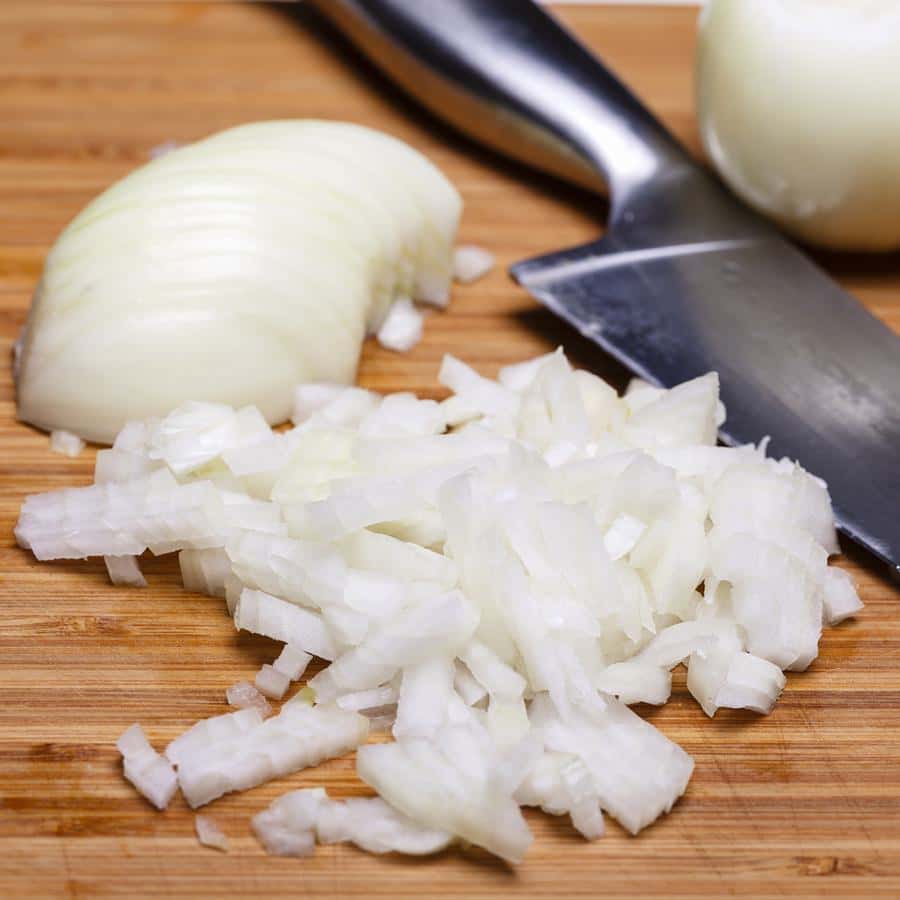
When a stinging insect inflicts its damage, what do you do to ease the pain? We’ve come across numerous home remedies, but one of the favorites that comes up time and again is onion. One reader made a slight change in the procedure by squeezing the vegetable to make onion juice.
Onion Juice for a Wasp Sting:
Q. I read about using a sliced onion on a bee or wasp sting. This trick worked after a wasp got me on my little finger.
I cut an onion and put it on the stung spot. It felt a little better, but I wanted faster relief. I chopped the onion into small pieces and put some in my garlic press. I squeezed the juice into a small bowl, soaked a gauze pad with it and applied it to my finger. Right away the pain was gone, and the swelling was much reduced.
A. Onions are unquestionably a popular remedy for stings.
More than 30 years ago, a reader shared this story about treating a yellow jacket sting:
“A friend told me to cut an onion and press the cut side to the sting, holding it there at least 10 minutes. I tried it the last time I got stung, and miracle of miracles, it really worked. I thought your other readers would like to know about this.”
Since then, we have heard from many other people that a fresh-cut onion can ease the pain of a sting. Your innovation to use onion juice is an interesting adaptation. The following might be the story you read about using sliced onion:
Sliced Onion for the Pain of a Wasp Sting:
Q. I was walking barefoot in my kitchen when I stepped on a wasp. Right away, I figured I was in trouble. I was stung for the first time ever a few days ago. My arm swelled so much I looked like Popeye the sailor man. It was horribly sore for a whole week.
So when I stepped on the wasp minutes ago, I immediately searched your website for a remedy. I read that a fresh cut onion could ease the pain, so I grabbed an onion slice and tied it to my foot with a plastic bag. Within a minute the pain was gone. I’m going to leave the onion in place a little longer in the hope that it will prevent swelling.
Onion to Counteract a Sting:
A. More than 30 years ago we heard from a reader of this column that an onion might help ease the inflammation and pain of a wasp sting.
He credited his German neighbor lady with
“suggesting a cut onion be applied to the sting for at least 10 minutes.”
At the time, we’d not heard of such a remedy. To learn more, we checked with an expert in onion chemistry, Dr. Eric Block, of the State University of New York at Albany. He confirmed that fresh cut onions (and presumably onion juice) contain an enzyme that can break down pro-inflammatory chemicals. This doesn’t appear to have been tested in any clinical trials, although one article in the medical literature lists onions as a way to treat stingray wounds (Medical Journal of Australia, June 1, 1998). Onion water and onion juice are common sting remedies among Turkish beekeepers (International Forum of Allergy & Rhinology, July 2014).
Other Approaches to Calm the Pain of a Wasp Sting:
There are other remedies that can help a wasp sting if you don’t have an onion handy. You might try meat tenderizer mixed with water. A paste of baking soda and water or vinegar may also help. You will find these and dozens more simple treatments for common ailments in our book, Quick & Handy Home Remedies.
Although we haven’t seen studies of onion juice for stings, Italian investigators have found that an extract of red onion skins could be beneficial for treating wounds (Molecules, Jan. 13, 2020). Chinese researchers have also identified compounds in onion juice and onion skins that have anti-neuroinflammatory action (Journal of Agricultural and Food Chemistry, Jan. 22, 2020). This might help soothe the pain of a sting.
Watch Out for Allergic Reactions:
Do keep in mind that an allergic reaction to a wasp sting can be extremely dangerous. Anyone who is allergic to stings should use an epinephrine autoinjector or seek emergency medical attention! Don’t bother fiddling with cutting onions or making onion juice in that situation. Another reader had a very frightening experience.
Q. A person recently wrote to you about a wasp sting. Although you mentioned the risk of anaphylactic shock in your response, I think you should have informed the writer that the next sting could be fatal.
I was stung by a wasp and my hand swelled. Two weeks later, I was stung again and immediately took a Benadryl (diphenhydramine) and put ice on my forehead. Within minutes, I was on the floor with no pulse or blood pressure.
Thanks to the Benadryl and to the paramedics who started two IVs before they got a 40/20 blood pressure reading, I am alive to tell about it. Since your writer had a severe reaction, it is obvious that she has an allergy to wasps and her next sting might be fatal. She and your other readers should be informed of this.
Evaluation Is Essential:
A. It can be difficult to determine when someone will develop anaphylactic shock in response to a sting. That said, you are right that the next sting might be fatal.
We urge anyone who has experienced a serious reaction to a sting to be evaluated by a physician. For those who are at risk of life-threatening anaphylaxis, keeping an EpiPen for self injection can be life saving. Even after an injection with this prescription epinephrine, emergency medical treatment must be summoned. Such individuals should not waste time with onion juice or other remedies.
Other Readers Offer Their Stories:
Many other readers have had serious reactions, underscoring the importance of being prepared.
RMH was saved by the EMT team:
“Several years ago I was stung by two wasps. I had anaphylactic reaction; luckily the EMT boys knew what to do, and by the time I got to the hospital, I was fully treated. The hospital ER verified this (for $1600.00) and I was released immediately.
“Since then I keep Epi-Pens in both cars, the house, and shaving kit (for travel). I’ve been stung once since then–at a fellow’s house looking at welding equipment. I immediately injected myself with the Epi-Pen, drove to the nearest EMT (about 9 miles), and sat in their facility until the reaction time had passed, then went home without any problems.”
MMM also had a scary situation:
“Although a person may experience a moderate reaction to a first sting, if you are so predisposed, any/all subsequent stings may result in death, predicated on the severity of the sting. I did not know I was this allergic, backed into a wasp nest and was stung 3 times. We headed home and, luckily, there was a hospital within a few minutes of there. My hands and feet started tingling, then I got a pounding headache. When my husband noticed, I had turned beet red.
“The tingling was due to anaphylaxis and constriction of blood vessels to the extremities. We rushed to the hospital and I was shot up with epinephrine and given benadryl. I would have been dead in 20 minutes.
“Be tested for this allergic reaction. Turns out I am allergic to bees, wasps and hornets and ALL mixed vespids. I took shots for 5 years, carry Benadryl and an epipen. Only true test is to be stung again. Don’t want to try that.
“For anyone who has experienced a reaction, it is imperative to find out if you too have this allergy. Turns out my mother and sister have the same allergy. For a honeybee sting, use a comb to whisk out the stinger. If you grab it, it will pinch out more venom. I love to garden and bees abound, so it is best to know if you are allergic, just in case!”
SPE saved her husband’s life:
“My husband has been stung by a wasp multiple times over the years. Two years ago, he had a wasp sting on the temple, started tingling and sweating, took 100mg Benadryl due to the severe oncoming reaction. Within minutes, he had a seizure and completely lost consciousness, loss urinary function, no pupil reaction, no BP or pulse. Luckily I was at home and am an RN. I immediately called 911 and worked with him for 20 minutes waiting for the rescue squad and EMS.
“We live in the county and EMS was on another call. It was a horrible experience. If I had not been home, he would not be here today. He was awake by the time EMS arrived; benadryl and quick response saved his life.
“We waited weeks before allergy testing (to eliminate a false + reading). He is highly allergic to wasp, moderately allergy to yellow jackets and other bees. He also keeps Epi-Pens in his vehicle, the house, and shaving kit. Do not take a chance with bee or wasp stings; you never know when a reaction will be severe.”
Citations
- Whiting SD & Guinea ML, "Treating stingray wounds with onions." Medical Journal of Australia, June 1, 1998.
- Çeliksoy MH et al, "Characteristics of venom allergic reactions in Turkish beekeepers and alternative treatment modalities." International Forum of Allergy & Rhinology, July 2014. DOI: 10.1002/alr.21314
- Pagano C et al, "Bioadhesive polymeric films based on red onion skins extract for wound treatment: An innovative and eco-friendly formulation." Molecules, Jan. 13, 2020. DOI: 10.3390/molecules25020318
- Li Q et al, "Health benefits of the flavonoids from onion: Constituents and their pronounced antioxidant and anti-neuroinflammatory capacities." Journal of Agricultural and Food Chemistry, Jan. 22, 2020. DOI: 10.1021/acs.jafc.9b07418


